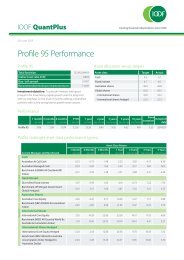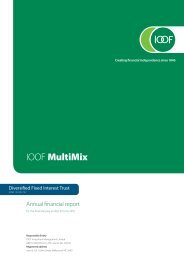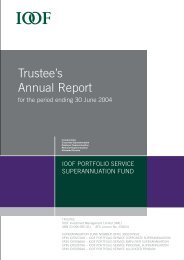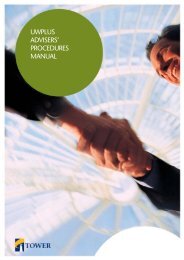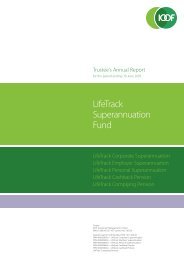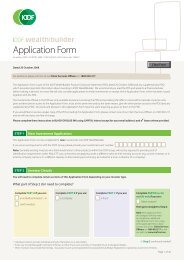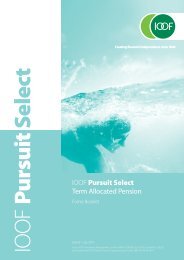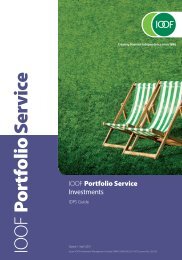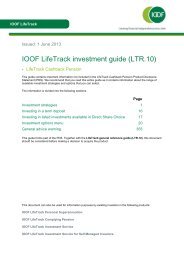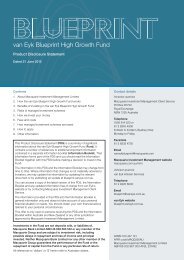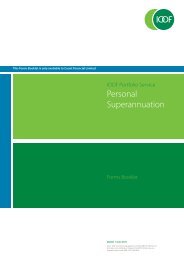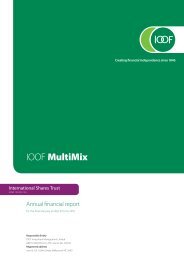annual report 2011
annual report 2011
annual report 2011
You also want an ePaper? Increase the reach of your titles
YUMPU automatically turns print PDFs into web optimized ePapers that Google loves.
IOOF | <strong>annual</strong> <strong>report</strong> <strong>2011</strong><br />
(ii)<br />
Cash flow and fair value interest rate risk<br />
(b) Credit risk<br />
Interest rate risk is the risk to the Group’s earnings and capital<br />
arising from changes in market interest rates. The financial<br />
instruments held that are impacted by interest rate risk consist<br />
of cash and cash equivalents, loans, and borrowings.<br />
Short and long-term investment mixes and loans to related<br />
entities are influenced by liquidity policy requirements. Interest<br />
rates (both that charged and received) are based on market<br />
rates, and are closely monitored by management. They are<br />
primarily at variable rates of interest, and expose the Group to<br />
cash flow interest rate risk.<br />
Management regularly assesses the appropriateness of the<br />
investment of surplus funds with the objective of maximising<br />
returns, within investment guidelines acceptable to the Board.<br />
There is limited exposure to fair value interest rate risk because<br />
of the relatively short time frame of any fixed rate investments<br />
and borrowings.<br />
The Parent has no exposure to interest rate risk.<br />
Group sensitivity<br />
At 30 June <strong>2011</strong>, if interest rates had changed by +/- 100<br />
basis points from the year-end rates with all other variables<br />
held constant, post tax profit for the year would have been<br />
$1,550,000 higher/lower (2010: change of +/- 100 basis points;<br />
$860,000 higher/lower). Equity would have been higher/lower<br />
by the same amount.<br />
(iii) Foreign exchange risk<br />
The Group was not exposed to significant foreign exchange<br />
risk in relation to financial instruments held at year end<br />
(2010: nil).<br />
Credit risk refers to the risk that a counterparty will fail to<br />
meet its contractual obligations resulting in financial loss to<br />
the Group. Credit risk arises for the Group from cash and cash<br />
equivalents, receivables, loans and other receivables.<br />
The Group mitigates its credit risk by ensuring cash deposits<br />
are held with high credit quality financial institutions and other<br />
highly liquid investments are held with trusts operated by the<br />
Group. Where investments are held in units in a trust operated<br />
by the Group, that trust is subject to the rules of the trust deed<br />
and the investment in underlying assets is subject to asset<br />
allocation guidelines.<br />
Receivables consist of management fees receivable, service<br />
fees receivable and mandate receivables and other amounts<br />
receivable from related parties. These counterparties generally<br />
do not have an independent credit rating, and the Group<br />
assesses the credit quality of the debtor taking into account its<br />
financial position, past experience with the debtor, and other<br />
available credit risk information. In relation to management<br />
fees receivable, the Group is contractually entitled to deduct<br />
such fees from investors’ account balances, in accordance<br />
with the Product Disclosure Statements, and pass the fees to<br />
the Responsible Entity or Trustee. Due to this pass-through<br />
process the embedded credit risk is considered minimal. Other<br />
receivables are regularly monitored by line management.<br />
The maximum exposure to credit risk at the <strong>report</strong>ing date is<br />
the carrying value of the financial assets as summarised in the<br />
table included in this note above. The Group does not hold<br />
any significant collateral as security over its receivables and<br />
loans, apart from its recourse to certain shares in subsidiaries in<br />
relation to loans to executives.<br />
There are no significant concentrations of credit risk within the<br />
Group.<br />
The Group does not hold any financial assets whose terms<br />
have been renegotiated, but which would otherwise be past<br />
due or impaired.<br />
The credit quality of the financial assets that are neither past<br />
due nor impaired as at balance date was consistent with that<br />
described above, and management assesses the credit risk<br />
associated with these <strong>report</strong>ed balances as being minimal.<br />
Information in relation to impaired receivables and past due<br />
but not impaired receivables is included below.<br />
page 69



